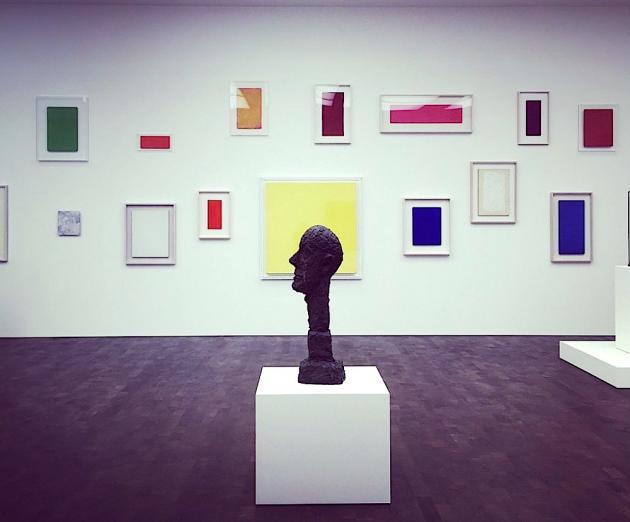A sumptuous exhibition at Gagosian, Grosvenor Hill, London presents the work of two of the 20th century’s greatest artists, juxtaposed in what turns out to be ‘a match made in heaven’. Alberto Giacometti and Yves Klein may not seem to be an obvious choice of artists for a two man show, however, there are stylistic similarities in the approach to their practices and it just works. Born a generation apart, the artists lived near to one another in Paris and their paths did cross. This is exemplified by a study that Giacometti produced on a news clipping for an Yves Klein Exhibition review.
Joachim Pissarro, a former curator at MoMa, NY and now an independent Curator, has made an astute observation in just how well these artists hang together. The harmony of form and simplicity of colour leave little room for distraction. He eloquently puts it into perspective by stating; “Both artists, rather than creating something that reflected the chaos, chose to rise above it, transforming and deciphering it into elegant, lyrical matter.” The works displayed are first rate examples of both artists including an example of Giacometti’s large bronze ‘Walking Man’ (L’Homme qui marche) which recently sold at Sotheby’s for $104m. The Kleins represented are among the best I’ve ever seen anywhere.
This is not your typical gallery show. It is yet another museum quality exhibition of the highest standard and calibre from Gagosian. Although a commercial gallery, and the world’s largest at that, Gagosian seems to be transcending into a league of its own setting: the marker higher and higher. Many of the works have been borrowed from the Fondation Alberto Giacometti and the Yves Klein Archives, with additional works from the Beyeler Foundation and private collections. Twenty-five sculptures by Giacometti — including such classics as the hieratic Femme de Venise I (1956), the austere L’homme qui marche I (1960), and the almost comic Le Nez (1947) are shown together with as many works from Klein, including Monochromes, Anthropometries, Fire Paintings, and a Sponge Sculpture. It is in the Anthropometries–direct impressions of the naked female body in blue paint on large sheets of paper–that Klein comes closest to Giacometti in his desire to record the human trace, albeit without any overt evidence of his own hand.
This is currently the best show in town, don’t miss it!
Paul Carter Robinson © Artlyst 2016

